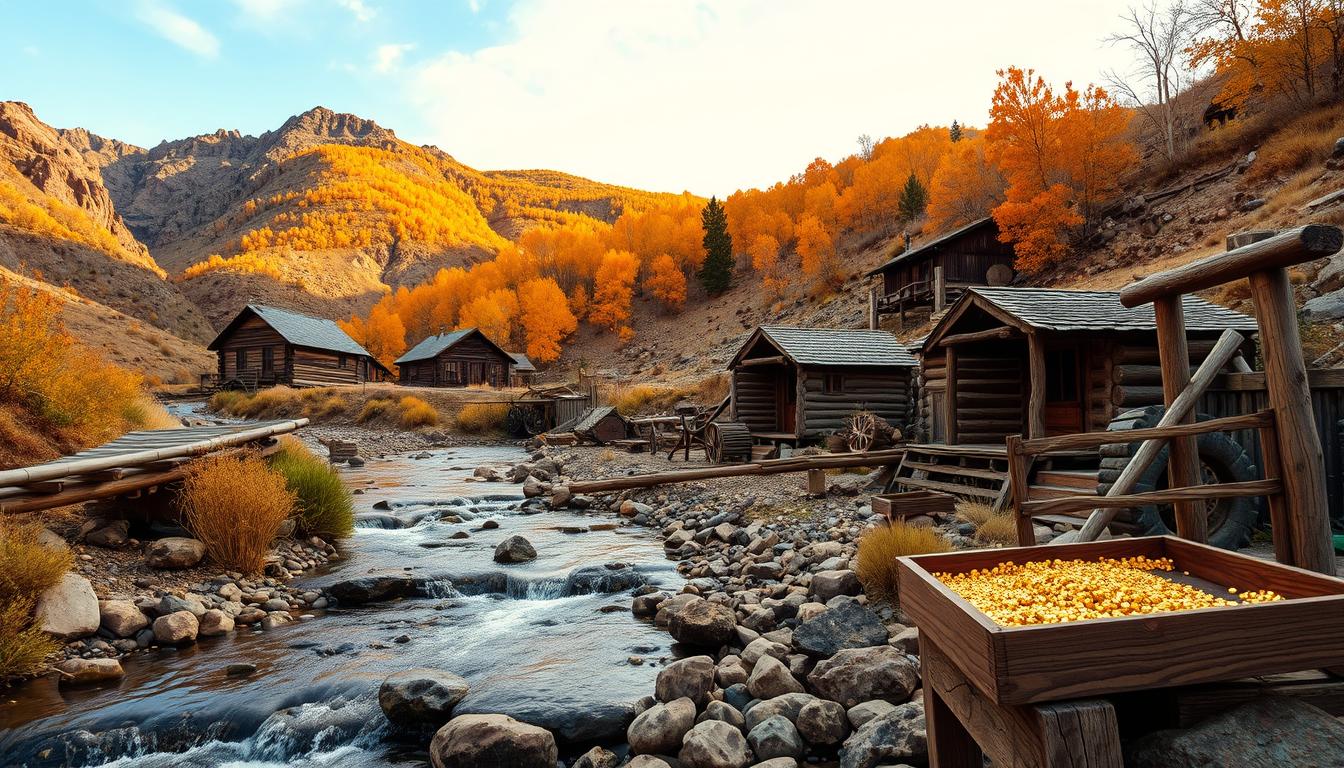Clear Creek County is in the heart of Colorado. It has a rich Gold Mining History that started on January 7, 1859. This discovery led to the county’s establishment.
With 86% of its land as national forest, it’s perfect for outdoor lovers and history fans. The county’s geography, with four peaks over 14,000 feet, drew miners and settlers in the 19th century.
Planning to visit Idaho Springs? Make sure to book a spot at Idaho Springs RV Resort & Campground. It’s open all year and is great for RVs or camping. After a day of exploring, it’s the perfect place to rest.
Clear Creek County’s mining history is a key part of Colorado’s past. It’s a must-see for anyone interested in the state’s fascinating history.
The Birth of Gold Mining in Clear Creek County
In 1859, gold was found in Clear Creek County, starting a new chapter in its history. This find drew many miners and settlers, changing the county’s economy and landscape. Today, visitors can see the Clear Creek River and mountains, perfect for mining.
George Andrew Jackson first found gold in January 1859. The first week’s mining made $1,900. This led to a gold rush, growing the settlement to 400 people by June 1859. The town site, over 105 acres, was bought for $1.25 per acre in 1873.
Overview of Clear Creek County’s Geographical Features
The Clear Creek River and mountains were key to gold mining here. The river’s close location to mountains made it great for mining gold. Now, visitors can explore these features and learn about mining history at the Phoenix Gold Mine.
The Discovery of Gold in the 1850s
The 1850s gold discovery brought many miners and settlers to the area. This led to the creation of Historical gold mining sites and the Clear Creek County gold rush. The area’s gold and geography made it a mining hotspot.
The Gold Rush Era: Boom and Bust
The gold rush era was a time of big change and growth for Clear Creek County. Many miners and settlers came looking for gold. This started in 1859 and had a big economic impact on local communities.
It shaped the area’s gold mining industry insights and Clear Creek County geological heritage. New businesses and communities popped up, making the economy thrive.
Historical records show both good and bad times during the gold rush era. Many mines were in operation, and the economy did well. But, this boom didn’t last long.
The peak of placer mining was from 1860 to 1863 and declined by 1875. Yet, the region’s gold mining industry insights kept growing. New mining techniques were found, and important gold mines were established.
The arrival of miners and settlers deeply affected local communities. As the population grew, so did the need for more infrastructure and services. The gold rush era shaped the region’s Clear Creek County geological heritage.
Today, many mining towns and communities still exist. Visitors can learn about the gold rush era and its effects at the Denver Museum of Nature & Science. They’ll gain valuable gold mining industry insights into the region’s rich history.
Influx of Miners and Settlers
The gold rush era brought a huge number of people to Clear Creek County. They all wanted to get rich. This led to the creation of new towns and communities.
These would become a key part of the region’s Clear Creek County geological heritage. As more people arrived, the demand for goods and services grew. This led to a booming economy.
Economic Impact on Local Communities
The gold rush era had a big economic effect on local communities. Many people made a lot of money, while others struggled. The region’s gold mining industry insights were shaped by this time.
New mining techniques were discovered, and important gold mines were found. When the gold rush era ended, the economy started to shift. It began to focus on other industries and activities.
Notable Gold Mining Techniques Used
Gold mining in Clear Creek County has a rich history. Many techniques were used to extract gold from the area’s geological features. Visitors can learn about these techniques at Colorado mining heritage sites, which showcase the county’s historical resources.
The area’s unique geology made it ideal for placer mining and hard rock mining. Placer mining involves extracting gold from streams and rivers. Hard rock mining involves extracting gold from rocks and ore.
Placer Mining: Techniques and Tools
Placer mining was a popular method in Clear Creek County. Miners used simple tools like pans and sluice boxes to extract gold. The Clear Creek County historical resources provide valuable insights into the lives of these miners and the techniques they used.

Hard Rock Mining Practices
Hard rock mining was also used in the area. Miners extracted gold from rocks and ore using more complex tools and equipment. Visitors to Colorado mining heritage sites can learn about the history of hard rock mining and its significance in the county’s development.
Iconic Gold Mines of Clear Creek County
Clear Creek County is famous for its gold mines. These mines are key to the area’s mining history. Visitors can explore these mines and learn about their history.
The Phoenix Gold Mine is a must-see. It offers tours and gold panning activities. This mine shows the area’s rich mining heritage.

The Legacy of the Creature Mine
The Creature Mine has a long history. It dates back to the gold rush era. Its story is one of perseverance and determination.
The Role of the Argo Tunnel
The Argo Tunnel is a major landmark. It played a big role in the area’s mining history. Its engineering is a wonder to see today.
The Growth of Mining Towns and Communities
The Clear Creek County gold rush brought a lot of wealth to the area. This led to the growth of mining towns like Central City and Idaho Springs. As the gold rush went on, these towns grew fast. Many people came to the area looking for gold.
Historical records show that the gold rush in Clear Creek County produced about 2,400,000 ounces of gold by 1959. This made it the seventh top gold-producing county in Colorado. The gold mining industry’s success greatly impacted the local economy and communities. Gold mining industry insights reveal that the growth of mining towns and communities was linked to the gold mining industry’s success.

Life in mining towns like Central City and Idaho Springs was shaped by the gold rush. Miners and their families lived and worked there, helping the local economy and community. The Clear Creek County gold rush greatly influenced the history and identity of these towns. Its legacy is still seen today.
The Rise of Central City and Idaho Springs
Central City and Idaho Springs were key mining towns in Clear Creek County. They grew fast during the gold rush era. Many businesses, schools, and community groups emerged to support the growing population.
The growth of these towns was tied to the gold mining industry’s success. They remain important parts of the county’s history and identity.
The Role of Homesteaders and Ranchers
Clear Creek County’s geological heritage is shaped by more than just historical gold mining sites. Homesteaders and ranchers also played a big role. The area’s landscape was perfect for both mining and farming. Settlers brought new ways and tools that helped grow the local economy.
The Homestead Act of 1862 drew settlers to the area. It allowed them to claim land and start farms and ranches. This led to more farming and ranching, helping the local economy grow. Mining and farming balanced each other, both important to the area’s history and economy.
Visitors to Clear Creek County can learn about homesteaders and ranchers at historical gold mining sites and museums. These places show the area’s rich Clear Creek County geological heritage. We can appreciate the complex history and economy of the region by understanding their contributions.
The legacy of homesteaders and ranchers is still seen today. Many of their farms and ranches are still working. The historical gold mining sites and farms show the hard work and determination of these early settlers. They helped create the Clear Creek County geological heritage we know today.
Environmental Impact of Gold Mining
The gold mining industry has greatly harmed the environment in Clear Creek County. This damage is still seen today. Gold mining industry insights reveal that 150 years of mining have changed the local ecosystem a lot. The 1870s saw the start of hydraulic mining, causing big damage to river banks and polluting streams for miles.
The Clear Creek County historical resources show a once-thriving area. Miners in Georgetown quickly depleted the timber and beaver populations. In the late 1800s, logging became a big industry in Idaho Springs. This led to the clear-cutting of hillsides and canyons, affecting the environment for years.
Now, Clear Creek County is working to fix the damage from gold mining. The Argo Tunnel Water Treatment Plant stops 1,200 pounds of heavy metals from entering Clear Creek every day. The Clear Creek Watershed Foundation has been working on projects since 1997. They focus on cleaning up abandoned mines and waste. These efforts are key to protecting the environment and keeping Clear Creek County beautiful.
Short-term vs. Long-term Environmental Effects
The effects of gold mining can be short-term or long-term. Short-term effects include pollution and habitat loss. Long-term effects include soil and water quality degradation. Knowing these effects helps in finding ways to restore the environment and lessen mining’s impact.
Restoration Efforts in Clear Creek County
Restoration work in Clear Creek County is ongoing. It aims to fix mined lands and protect wildlife habitats. For example, the Capital Prize mine dump was capped in 2022. These efforts are vital for preserving Clear Creek County’s natural beauty and ensuring a healthy environment for the future.
Modern Gold Mining: A New Era
Gold mining in Colorado has changed a lot over the years. Now, it focuses on modern ways and rules. This change helps protect the environment while keeping the mining history alive. At places like the Phoenix Gold Mine, you can learn about these new methods and even try gold panning.
In Clear Creek County, mining is now more eco-friendly. The Clear Creek County Mining Tours show how gold mining has evolved. With cheaper transport costs, there’s a chance for a small boom in gold mining in Colorado.
The gold mining industry is growing, and finding a balance is key. New mills in Clear Creek and Jefferson County show the industry’s growth. By visiting Colorado mining heritage sites and joining Clear Creek County Mining Tours, you can understand the area’s mining history and today’s mining practices.
Preserving Gold Mining Heritage
Clear Creek County is proud of its gold mining history. Visitors can explore this fascinating past by checking out gold mining landmarks and historical resources. Museums, historic sites, and ghost towns offer a glimpse into the county’s mining days.
Community efforts are key in keeping this heritage alive. The Clear Creek County Historical Society works hard to save important sites. They make sure these landmarks are open for everyone to see. You can also join mining tours to learn more about the area’s mining history.
Exploring abandoned mills, panning for gold, or seeing exhibits at the Denver Museum of Nature & Science is unforgettable. It lets you connect with Clear Creek County’s mining past. By preserving this heritage, the community keeps the stories of mining pioneers alive for all to enjoy.

